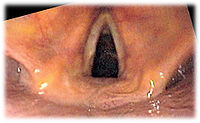
Photo from wikipedia
Background. There are increasing numbers of videolaryngoscopes marketed and increasing interest in the technology. The Difficult Airway Society's 2015 guidelines recommend that videolaryngoscopes should be immediately available at all times… Click to show full abstract
Background. There are increasing numbers of videolaryngoscopes marketed and increasing interest in the technology. The Difficult Airway Society's 2015 guidelines recommend that videolaryngoscopes should be immediately available at all times and that all anaesthetists should be trained and skilled in their use. Methods. An electronic survey was sent to all UK National Health Service hospitals to examine availability, use, and attitudes to videolaryngoscopy, and closed in January 2014. Results. The return rate was 67%. Videolaryngoscopy was available in 91% of operating theatres, ∼50% of intensive care units (ICUs) and obstetric theatres, with lower availability in emergency departments (EDs), paediatric anaesthesia, and independent sector hospitals. The most widely available devices were the Airtraq, the GlideScope, and C-MAC. Approximately one in seven respondents reported availability of videolaryngoscopy in all clinical areas. Most departments imposed restrictions on videolaryngoscopy use, especially the ICU and ED. Device selection was only infrequently based on published literature or formal trial. Structured introduction of videolaryngoscopy into practice was uncommon. Penetration of videolaryngoscopy was highly variable; fewer than a third reported widespread use or enthusiasm, although this increased where the C-MAC and GlideScope were widely available. Conclusions. Videolaryngoscopy is available in most hospitals' main operating departments, but in fewer than half of other locations. There is marked variation in device, methods of introduction, usage, and clinical adoption. Most hospitals need to change practice to comply with current guidelines. Selection and implementation vary widely.
Journal Title: British journal of anaesthesia
Year Published: 2017
Link to full text (if available)
Share on Social Media: Sign Up to like & get
recommendations!